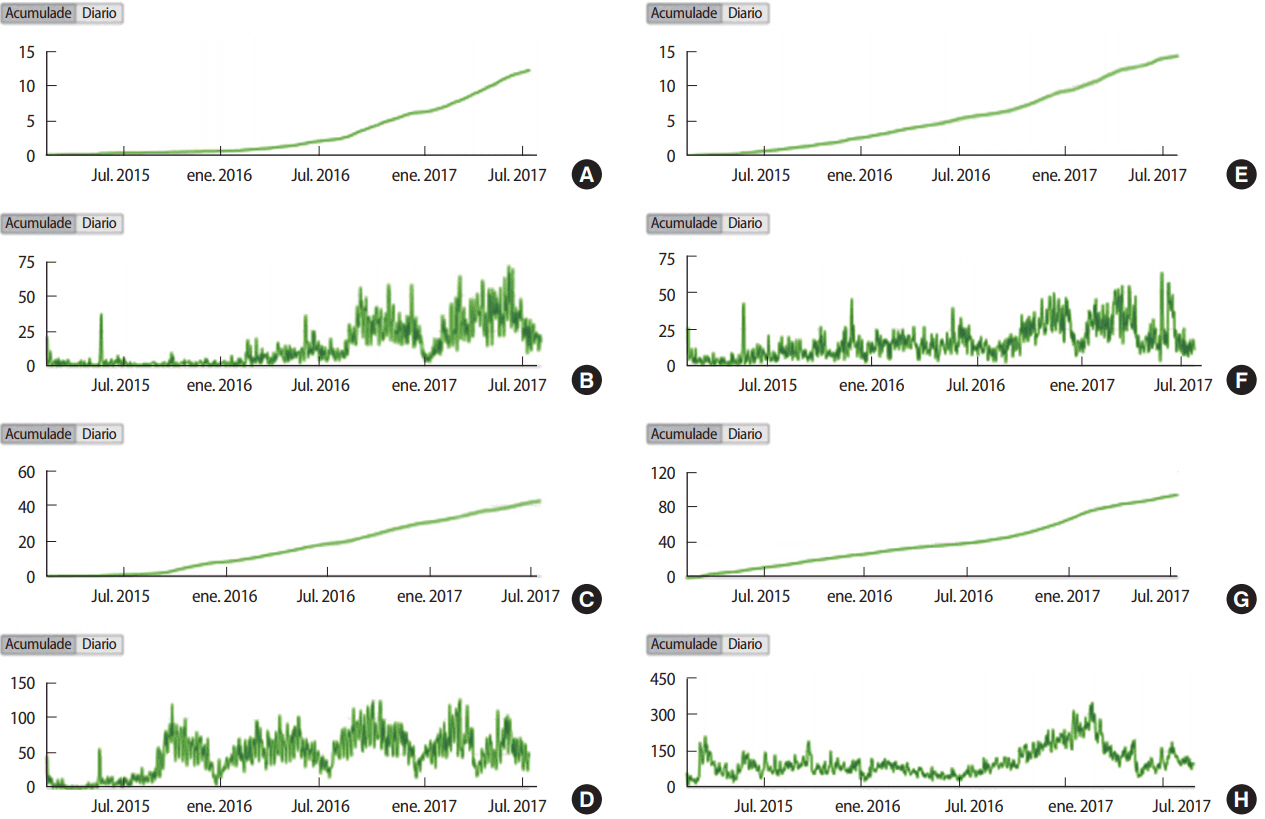J Educ Eval Health Prof.
2017;14:31. 10.3352/jeehp.2017.14.31.
The reach of Spanish-language YouTube videos on physical examinations made by undergraduate medical students
- Affiliations
-
- 1Department of Clinical Medicine, School of Medicine, Sant Joan d'Alacant Campus, Miguel Hernandez University of Elche, Elche, Spain. jose.ramosr@goumh.umh.es
- 2Department of Pediatrics, School of Medicine, Sant Joan d'Alacant Campus, Miguel Hernandez University of Elche, Elche, Spain.
- 3Innovation and Teaching Support Service, Elche Campus, Miguel Hernandez University of Elche, Elche, Spain.
- 4Independent Researcher, Valencia, Spain.
- KMID: 2406694
- DOI: http://doi.org/10.3352/jeehp.2017.14.31
Abstract
- This study was conducted to evaluate the performance and reach of YouTube videos on physical examinations made by Spanish university students. We analyzed performance metrics for 4 videos on physical examinations in Spanish that were created by medical students at Miguel Hernández University (Elche, Spain) and are available on YouTube, on the following topics: the head and neck (7:30), the cardiovascular system (7:38), the respiratory system (13:54), and the abdomen (11:10). We used the Analytics application offered by the YouTube platform to analyze the reach of the videos from the upload date (February 17, 2015) to July 28, 2017 (2 years, 5 months, and 11 days). The total number of views, length of watch-time, and the mean view duration for the 4 videos were, respectively: 164,403 views (mean, 41,101 views; range, 12,389 to 94,573 views), 425,888 minutes (mean, 106,472 minutes; range, 37,889 to 172,840 minutes), and 2:56 minutes (range, 1:49 to 4:03 minutes). Mexico was the most frequent playback location, followed by Spain, Colombia, and Venezuela. Uruguay, Ecuador, Mexico, and Puerto Rico had the most views per 100,000 population. Spanish-language tutorials are an alternative tool for teaching physical examination skills to students whose first language is not English. The videos were especially popular in Uruguay, Ecuador, and Mexico.
Keyword
MeSH Terms
Figure
Reference
-
References
1. Alpert JS. Will physicians stop performing physical examinations? Am J Med. 2017; 130:759–760. https://doi.org/10.1016/j.amjmed.2017.03.013.
Article2. Azer SA, Algrain HA, AlKhelaif RA, AlEshaiwi SM. Evaluation of the educational value of YouTube videos about physical examination of the cardiovascular and respiratory systems. J Med Internet Res. 2013; 15:e241. https://doi.org/10.2196/jmir.2728.
Article3. Duvivier RJ, van Geel K, van Dalen J, Scherpbier AJ, van der Vleuten CP. Learning physical examination skills outside timetabled training sessions: what happens and why? Adv Health Sci Educ Theory Pract. 2012; 17:339–355. https://doi.org/10.1007/s10459-011-9312-5.
Article4. Micheel CM, Anderson IA, Lee P, Chen SC, Justiss K, Giuse NB, Ye F, Kusnoor SV, Levy MA. Internet-Based Assessment of Oncology Health Care Professional Learning Style and Optimization of Materials for Web-Based Learning: Controlled Trial With Concealed Allocation. J Med Internet Res. 2017; 19:e265. https://doi.org/10.2196/jmir.7506.
Article5. Azer SA, Aleshaiwi SM, Algrain HA, Alkhelaif RA. Nervous system examination on YouTube. BMC Med Educ. 2012; 12:126. https://doi.org/10.1186/1472-6920-12-126.
Article6. Camm CF, Sunderland N, Camm AJ. A quality assessment of cardiac auscultation material on YouTube. Clin Cardiol. 2013; 36:77–81. https://doi.org/10.1002/clc.22080.
Article7. Ronen S, Gonçalves B, Hu KZ, Vespignani A, Pinker S, Hidalgo CA. Links that speak: the global language network and its association with global fame. Proc Natl Acad Sci U S A. 2014; 111:E5616–E5622. https://doi.org/10.1073/pnas.1410931111.
Article8. Barry DS, Marzouk F, Chulak-Oglu K, Bennett D, Tierney P, O’Keeffe GW. Anatomy education for the YouTube generation. Anat Sci Educ. 2016; 9:90–96. https://doi.org/10.1002/ase.1550.
Article9. Sanchez-Mendiola M, Morales-Castillo D, Torruco-Garcia U, VarelaRuiz M. Eight years’ experience with a Medical Education Journal Club in Mexico: a quasi-experimental one-group study. BMC Med Educ. 2015; 15:222. https://doi.org/10.1186/s12909-015-0499-7.
Article10. Margolis A, Gonzalez-Martinez F, Noboa O, Abbud-Filho M, Lorier L, Nin M, Silvarino R, Garcia S, Pefaur J, Greloni GC, Noronha IL, Lopez A, Ribeiro-Alves MA, Tanus R, Fernandez-Cean J. Online continuing medical education for the Latin American nephrology community. Stud Health Technol Inform. 2015; 216:372–375.
- Full Text Links
- Actions
-
Cited
- CITED
-
- Close
- Share
- Similar articles
-
- Quality Evaluation of Korean YouTube Videos as a Source of Information on Malignant Melanoma
- YouTube as a source of information about rubber dam: quality and content analysis
- Content Analysis of Korean Videos Regarding Restless Legs Syndrome on YouTube
- A Preliminary Study on Uncovering Medical Students' Unprofessional Behaviors from YouTube Videos
- Evaluation of the reliability and information quality of YouTube videos on implant overdenture


